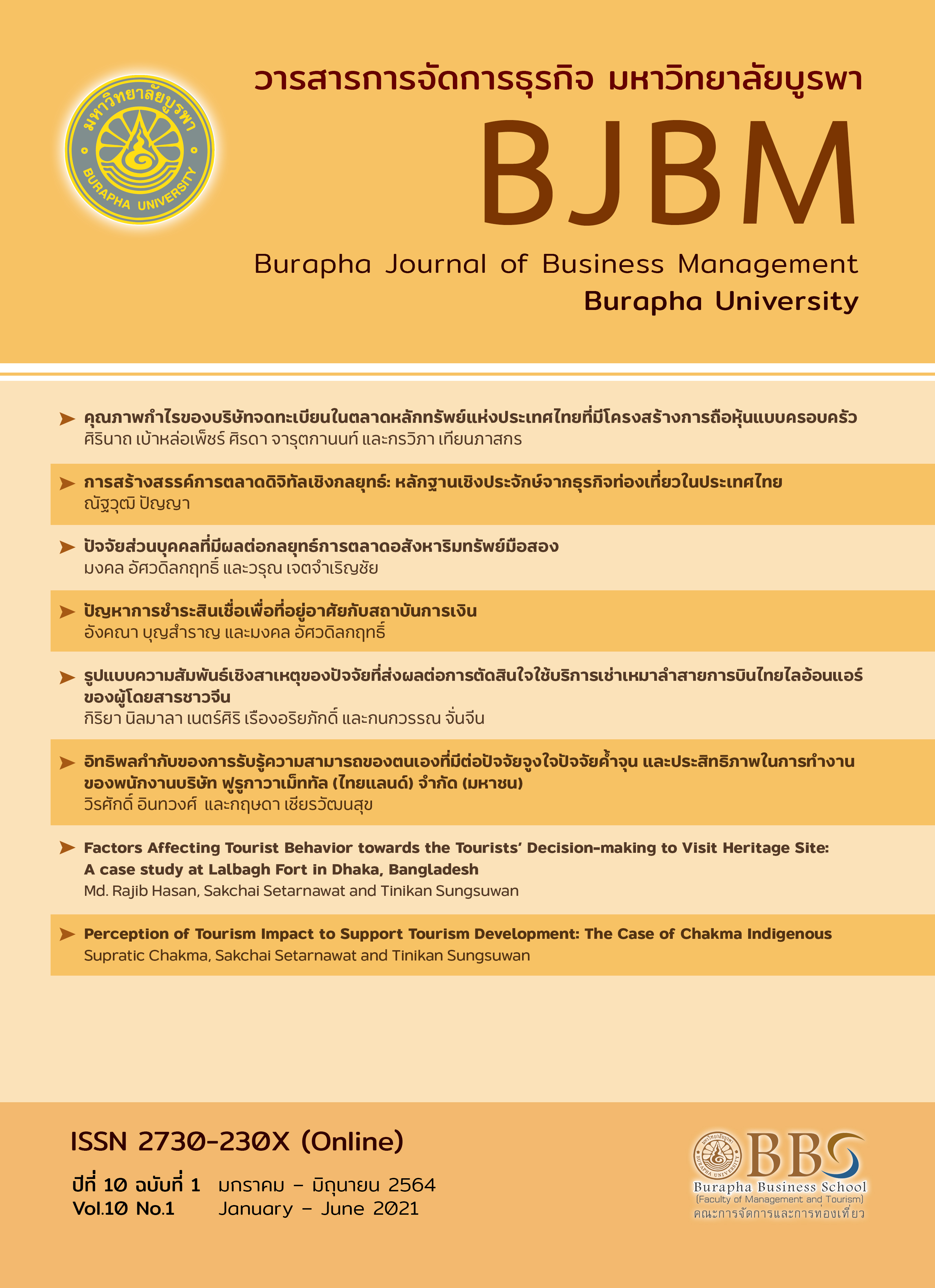การสร้างสรรค์การตลาดดิจิทัลเชิงกลยุทธ์ : หลักฐานเชิงประจักษ์จากธุรกิจท่องเที่ยวในประเทศไทย
Main Article Content
บทคัดย่อ
การศึกษาในครั้งนี้มีวัตถุประสงค์เพื่อศึกษาอิทธิพลของการสร้างสรรค์การตลาดดิจิทัลเชิงกลยุทธ์ต่อผลการดำเนินงานทางการตลาดของธุรกิจท่องเที่ยวในประเทศไทย ซึ่งงานวิจัยได้นำเสนอองค์ประกอบใหม่ (New Dimension) ของ การสร้างสรรค์การตลาดดิจิทัลเชิงกลยุทธ์ จำนวน 4 องค์ประกอบ โดยมีประชากรเป็นผู้ประกอบการธุรกิจที่พักแรมและธุรกิจนำเที่ยว จำนวนทั้งสิ้น 1,537 ธุรกิจ ใช้กลุ่มตัวอย่างจำนวน 323 ตัวอย่าง คิดเป็นอัตราการตอบกลับ 23.96 % ผู้ให้ข้อมูลหลักคือเจ้าของธุรกิจ ผู้บริหาร ผู้จัดการทั่วไป หรือผู้จัดการแผนก และใช้สถิติการวิเคราะห์การถดถอยพหุคูณ ในการทดสอบสมมติฐาน ผลการศึกษา พบว่า ทุกองค์ประกอบมีอิทธิพลต่อผลการดำเนินงานทางการตลาด กล่าวคือ สามารถร่วมกันอธิบายการเปลี่ยนแปลงของผลการดำเนินงานทางการตลาด ได้ร้อยละ 32.6 (Adjust R2) โดยสามารถจำแนกออกเป็นองค์ประกอบต่าง ๆ ที่ส่งผลมากที่สุดเรียงตามลำดับ คือ การติดตามสถานการณ์ทางการตลาดอย่างต่อเนื่อง จะมีอิทธิพลต่อผลการดำเนินงานทางการตลาดมากที่สุด(β1 = 0.283, p < 0.05) รองลงมาคือ ประสิทธิภาพของกลยุทธ์การตลาดอินเตอร์เน็ต (β2 = 0.302, p < 0.01) ลำดับถัดมาคือ องค์ความรู้เกี่ยวกับเทคโนโลยีดิจิทัลที่หลากหลาย (β3 = 0.291, p < 0.01) โดยมีองค์ประกอบวิสัยทัศน์ด้านการตลาดดิจิทัล เป็นปัจจัยที่ผู้ประกอบการธุรกิจโรงแรมเห็นว่ามีอิทธิพลต่อผลการดำเนินงานทางการการตลาดน้อยกว่าทุกปัจจัยที่กล่าวมา (β4 =0.362, p < 0.01) ผลการศึกษาพบว่า ทุกองค์ประกอบ มีอิทธิพลต่อผลการดำเนินงานทางการตลาด อย่างมีนัยสำคัญ ดังนั้น จึงสนับสนุนสมมติฐานที่กำหนดไว้ทุกข้อ นอกจากนี้ ผู้วิจัยยังให้คำแนะนำในการนำผลการศึกษาไปใช้ประโยชน์แก่ผู้ที่สนใจ รวมถึงนำเสนอประเด็นวิจัยในอนาคตที่สมควรศึกษาเพิ่มเติม เพื่อให้ผลการศึกษามีความสมบูรณ์มากยิ่งขึ้น
Article Details
บทความที่จะตีพิมพ์เพื่อเผยแพร่ในวารสารการจัดการธุรกิจ มหาวิทยาลัยบูรพา จะต้องเป็นบทความที่ไม่เคยได้รับการตีพิมพ์เผยแพร่หรืออยู่ระหว่างการพิจารณาเพื่อตีพิมพ์เผยแพร่ในวารสารอื่น ๆ ทั้งนี้ หากพบว่ามีการละเมิดลิขสิทธิ์ ด้วยข้อคิดเห็นที่ปรากฏและแสดงในเนื้อหาบทความต่าง ๆ ให้ถือว่าเป็นความเห็นและความรับผิดชอบโดยตรงของผู้เขียนบทความนั้น ๆ มิใช่ความเห็นและความรับผิดชอบใด ๆ ของคณะบริหารธุรกิจ มหาวิทยาลัยบูรพา สำหรับในกรณีผู้ประสงค์จะนำข้อความในวารสารการจัดการธุรกิจ มหาวิทยาลัยบูรพา ไปเผยแพร่ต้องได้รับอนุญาตจากกองบรรณาธิการวารสารการจัดการธุรกิจ มหาวิทยาลัยบูรพา ตามกฎหมายว่าด้วยลิขสิทธิ์
เอกสารอ้างอิง
กรมพัฒนาธุรกิจการค้า. (2563) ข้อมูลธุรกิจ. สืบค้นเมื่อ 4 มีนาคม 2563 สืบค้นจาก https://www.dbd.go.th/ download/document_file/Statisic/2563/T26/Business2020.pdf
กระทรวงการท่องเที่ยวและกีฬา. (2562). ผู้ประกอบธุรกิจนำเที่ยว. สืบค้นเมื่อ 16 กันยายน 2562 จาก https://thailandtourismdirectory.go.th.
จุฬารัตน์ ขันแก้ว. (2562). กลยุทธ์การตลาดดิจิทัลและผลการดำเนินงานทางการตลาดหลักฐานเชิงประจักษ์ จากธุรกิจบริการในประเทศไทย. จุฬาลงกรณ์ธุรกิจปริทัศน์, 41(159), 1-32.
ฐานเศรษฐกิจ. (2562). ท่องเที่ยว11เดือน ปี 62 โต3.88% จีนทะลุ10ล.คน อินเดียพุ่ง26%. สืบค้นเมื่อ 10 มกราคม 2563 สืบค้นจาก https://www.thansettakij.com/content/business/417452.
ปรีชา ตรีสุวรรณ. (2557). อุตสาหกรรมการท่องเที่ยว คืออะไร สำคัญอย่างไร. สืบค้นเมื่อ 10 มกราคม 2563 สืบค้นจาก https://www.facebook.com/487643448028956/posts/573996916060275/
พระราชบัญญัติธุรกิจนำเที่ยวและมัคคุเทศก์. (2551). มาตรา 4. ราชกิจจานุเบกษา เล่ม 125/ตอนที่29ก/
หนา 1/6 กุมภาพันธ์ 2551.
ราณี อมรินทร์รัตน์. (2560). ปัจจัยความสำเร็จของการตลาดเชิงสัมพันธ์ในอุตสาหกรรมท่องเที่ยว. วารสารวิจัยและพัฒนา วไลยอลงกรณ์ ในพระบรมราชูปถัมภ์ สาขามนุษยศาสตร์และสังคมศาสตร์, 12(2), 321-329.
สมชาติ อู่อ้น. (2552). การท่องเที่ยวเชิงนิเวศและการวางแผน. นครปฐม : ภาควิชาภูมิศาสตร์, คณะอักษรศาสตร, มหาวิทยาลัยศิลปากร.
สมาคมโรงแรมไทย. (2562). รายชื่อโรงแรม/รีสอร์ท ที่ได้รับการรับรองมาตรฐานที่พักเพื่อการท่องเที่ยว. สืบค้นเมื่อ16 กันยายน 2562 สืบค้นจาก http://www.thaihotels.org.
อภิชยาภรณ์ ชุณหเวชสกุล และ ศิวารัตน์ ณ ปทุม. (2562). กลยุทธ์การตลาดเชิงสร้างสรรค์และการโฆษณาเนื้อหาการท่องเที่ยวไทยที่ส่งผลต่อพฤติกรรมการใช้จ่ายของนักท่องเที่ยวชาวเกาหลีใต้ ในรุ่นเจเนอเรชั่นวาย. วารสารการบริการและการท่องเที่ยวไทย, 14(1), 42-57.
ณัฐวีร์ ตันติสัจธรรม. (2561). 5 สิ่งที่ Digital Marketing ไทย ยังตาม Digital Marketing ของ ต่างประเทศ. สืบค้นเมื่อวันที่ 5 มกราคม 2563 สืบค้นจาก https://stepstraining.co/content/digital-marketing-thai-global.
ไทเกอร์. (2562). แผนการตลาดคืออะไร? การเขียนแผนการตลาดแบบง่ายๆ. สืบค้นเมื่อ12 ธันวาคม 2562
สืบค้นจาก https://thaiwinner.com/marketing-plan/.
Aaker, D. A., Kumar, V., & Day, G. S. (2001). Marketing Research. New York: John Wiley and Sons.
Blazevic, V. & Lievens, A. (2004). Learning during the New Financial Service Innovation Process Antecedents and Performance Effects. Journal of Business Research, 57(4),
-391.
Chaffey, D. (2013). Definitions of E-marketing vs Internet vs Digital marketing, Smart Insight Blog, Retrieved February 16, 2020, from https://www.smartinsights.com/digital-marketing-strategy/online-marketing-mix/definitions-of-emarketing-vs-internet-vs-digital-marketing/.
Classen, M. & Friedli, T. (2019). Value-Based Marketing and Sales of Industrial Services: A Systematic Literature Review in the Age of Digital. Procedia CIRP, 83(2019), 1–7.
Daft, R. (1988), Management. New York: Dryden Press.
Day, S. & Wensley, R. (1988). Assessing Advantage: A framework for Diagnosing Competitive Superiority. Journal of Marketing, 52(2), 1-20.
Goldenberg, J., Mazursky, D. & Soloman, S. Templates of Original Innovation: Projecting Original Incremental Innovations from Intrinsic Information. Technological Forecasting and Social Change, 61(1), 1-12.
Grant, R. M. (1996). Prospering in Dynamically-Competitive Environments: Organizational Capability as Knowledge Integration. Organization Science, 7(4), 375-387.
Green, K. M., Covin, J. G., & Slevin, D. P. (2007). Exploring the Relationship between Strategic Reactiveness and Entrepreneurial Orientation: The Role of Structure-style Fit. Journal of Business Venturing, 23(3), 356-383.
Hair, J. F., Black, W. C., Babin, B. J., & Anderson, R. E. (2010). Multivariate Data Analysis: A Global Perspective. (7th ed). New Jersey: Pearson Education Inc.
Happ, E. & Ivancso-Horvath, Z. (2018). Digital Tourism is the Challenge of Future–a New Approach to Tourism. Knowledge Horizons. Economics, 10(2), 9–1.
Hsieh, M. H., Tsai, K. H., & J. R. Wang. (2008). The Moderating Effects of Market Orientation and Launch Proficiency on the Product Advantage-Performance Relationship. Industrial Marketing Management, 37(5), 580-592.
Jagongo, A., & Kinyua, G. (2013). The Social Media and Entrepreneurship Growth. International Journal of Humanities and Social Science, 3(10), 213-227.
Kogut, B. & Zander, U. (1992). Knowledge of the Firm, Combinative Capabilities, and the Replication of Technology. Organization Science, 3(3), 383-397.
Kogut, B. (1996). What firms do? Coordination, Identity, and Learning. Organization Science, 7(5), 502-518.
Krejcie, R. V. & Morgan, D. W. (1970). Determining Sample Size for Research Activities. Educational and Psychological Measurement, 30(3), 607-610.
Lichtenthaler, U & Lichtenthaler, E. (2009). A Capability‐Based Framework for Open Innovation: Complementing Absorptive Capacity. Journal of Management Study, 46(8), 1315-1338.
Liebermann, M. B. & Dhawan, R. (2005). Assessing the Resource Base of Japanese and US Auto Producers: A Stochastic Frontier Function Production Approach. Management Science, 51(7), 1060-1075.
Mark, L. (1996). Opinion: Demystifying the Development of an Organizational Vision. Sloan Management Review Reprint Series, 37(4), 83-92.
McGivern, H. & Tvori, J. (1998). Vision Driven Organizations: Measurement Techniques for Group Classification. Management Decision, 36(4), 241-264.
Mohammad, A. & Louisa, H. (2019). Engagement and Brand Loyalty through Social Capital in Social Media. International Journal of Internet Marketing and Advertising, 13(3), 197-217.
Nakata, C., Zhu, Z., & Izberk-Bilgin, E. (2011). Integrate Marketing and Information Services Functions: A Complementary and Competence Perspective. Journal of the Academic Marketing Science, 39(5), 700-716.
Neter, J., William, W., & Michael, H. K. (1985). Applied Linear Statistical Models: Regression, Analysis of Variance, and Experimental Designs. (2nd ed). Homewood: Richard D. Irwin.
Ngai, E. W. T. (2003). Commentary Internet Marketing Research (1987-2000): A Literature Review and Classification. European Journal of Marketing, 37(1/2), 24-49.
Nunnally, J. C. & Bernstein, I. H. (1994). Psychometric Theory. (3rd ed.). New York: McGraw-Hill.
Pataraarechachai, V. & Ussahawanitchakit, P. (2010). Strategic Transformational Leadership and Sustainable Competitive Advantage: Evidence from Furniture Business in Thailand. Journal of International Business and Economics, 10(4), 140-163.
Quintana-Garcia, C. &. Benavides-Velasco, A. (2009). Innovative Competence, Exploration and Exploitation: The Influence of Technological Diversification. Research Policy, 37(3), 492-507.
Rico, R., Sanchez-Manzanares, M., Gil, F., & Gibson, C. (2008). Team Coordination Processes: A Team Knowledge-based Approach. Academy of Management Review, 33(1), 163-185.
Rivard, S., Raymond, L. & Verreault, D. (2006). Resource-Based View and Competitive Strategy: An Integrated Model of the Contribution of Information Technology to Firm Performance. Journal of Strategic Information Systems, 15(1), 29-50.
Victoria State Government Education and Training. (2019). Teach with Digital Technologies. Retrieved November 27, 2019, from https://www.education.vic.gov.au/Pages/ default.aspx
Vorhies, D. W. & Morgan, N. A. (2005). Benchmarking Marketing Capabilities for Sustainable Competitive Advantage. Journal of Marketing, 69(1), 80-94.
Yeunyong, W. & Ussahawanitchakit, P. (2009). AIS Success of Thai Foods Businesses: An Empirical Investigation of Its Antecedents and Consequences. International Journal of Business Strategy, 9(1), 13-29.


